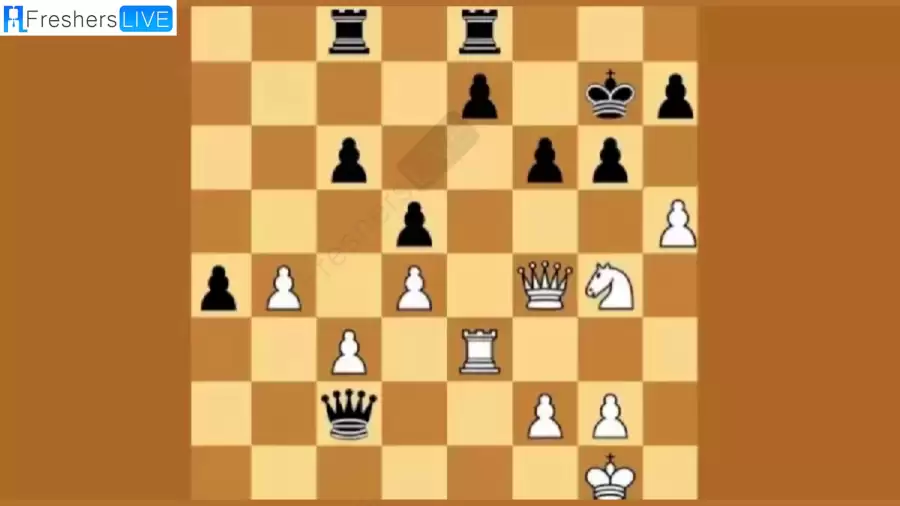Just 3 steps to solve this white puzzle!
Picture puzzle questions are based on visual images or pictures. They come in many forms, such as riddles, puzzles, or trivia questions. Regardless of the format, solving picture puzzles requires the solver to carefully examine and examine the visual elements presented to them.
A common type of picture puzzle is the “spot the difference” puzzle, which provides two images that are almost identical, but with subtle differences between them. The solver must find and identify all differences between the two images, which can be very challenging as some differences can be subtle.
You are watching: Solve This White-to-Move Chess Puzzle in Just 3 Moves!
Another type of picture puzzle is a visual riddle, which presents a visual image or picture and asks questions based on what is depicted in the image. For example, a visual riddle might present an image of a person standing in front of a door, holding three keys, and ask which key opens the door.
These puzzles require the puzzle solver to carefully analyze the image and may require lateral thinking to arrive at the correct answer. We pose a question to you in the image below. Your time to solve the puzzle begins now, so give it your best shot! If you can’t solve this puzzle, don’t worry. You can continue reading the article to find the solution.
Discover the fun of solving brain teasers on NEWSTARS Education, a delightful pastime for curiosity.Every puzzle you solve is one step closer to mastering the art of critical thinking

Just 3 steps to solve this white puzzle! – solution
We will find the answers to the difficult questions posed in the article above. We’re all eager to know the answers, so let’s get started. First, we’ll reveal the answer and then explain the reasons behind it.
If you stay calm and relaxed, you can even solve the difficult problems before us. We believe every problem has a solution.
See more : Observation Brain Test: If you have Hawk Eyes Find the Number 1990 among 1970 in 15 Secs
While some puzzles may seem challenging, the answers may be simple. On the other hand, some puzzles may seem simple but require effort to solve. Ultimately, the difficulty of a puzzle depends on the specific puzzle itself.
Looking closely at the picture above, we get the answer. The answer is given not only to those who did not find it, but also to those who predicted it wrong.
It’s okay to make mistakes, as long as we learn from them. If you want to know the answer, keep reading this article. In each puzzle, there is a reason why a particular answer is correct.
Everyone may have their own reasons when looking for answers, but ultimately there is only one right answer and one specific reason. This is especially true for brain puzzles. Let’s take a closer look at why this answer is correct.

move 2

Mobile 3

trend
Can you solve this problem 1+2=10, 2+3=22, 4+5=?
Let’s break it down. In the first equation, 1+2² equals 5, which multiplied by 2 gives us 10. Applying the same logic to the second equation, 4+5² equals 29, then multiplying by 2 gives us 4+5 = 4 +5² = 29 → 29×2 = 58.
Determine the answer to this equation 53-50÷10+6-55÷11=?
We start by dividing: 50 ÷ 10 equals 5, 55 ÷ 11 equals 5. Substituting these results, we simplify the equation to 53 – 5 + 6 – 5. Continuing the math, we subtract 5 from 53 to get 48, and then add 6 to get 54. Finally, we complete the equation and find that 53 – 50 ÷ 10 + 6 – 55 ÷ 11 equals 49.
Try solving this 35÷5×4+1-6
Following the order of operations, we first perform the division: 35 ÷ 5 equals 7. Then, multiplying, we get 7 x 4, which is equal to 28. Add 1 to 28 to get 29, then subtract 6 from the 29 result and the final answer is 23. Therefore, equation 35 ÷ 5 x 4 + 1 – 6 =23.
Try this challenge 1-1=0, 2-1=3, 6-1=?
Now, here comes the puzzle: When 6-1 follows the same pattern, what is the result? For equation 1-1, this translates to 1² – 1, which is equal to 0. Applying the same rule to 6-1, it becomes 6² – 1, giving us the answers 1-1=0, 2-1=3, 6 -1=35.
Let’s see if you can solve this 1+6=7, 2+7=16, 3+8=27, 6+11=?
Sequence expansion: 1+6 equals 7, 2+7 becomes 16, 3+8 becomes 27. Now, the mystery deepens: when we solve 6+11 in this mode, what is the result?
In the initial equation, 1+6 equals 7, which means 1 times 6 plus 1. Similarly, 2+7 totals 16, where 2 times 7 plus 2 gives 16. Extending this rule, 6+11 takes the form of 6 times 11 plus 6, resulting in 6+11= (11×6)+6 = 66+6=72.
Disclaimer: The above information is for general information purposes only. All information on this website is provided in good faith, but we make no representations or warranties, express or implied, as to the accuracy, adequacy, validity, reliability, availability or completeness of any information on this website.
Source: https://truongnguyenbinhkhiem.edu.vn
Category: Brain Teaser
